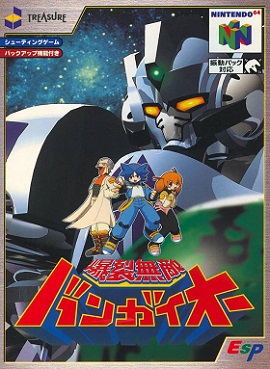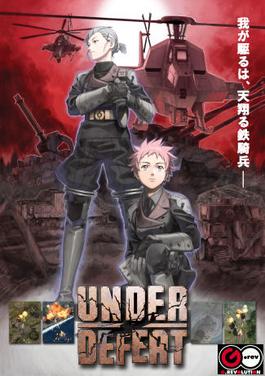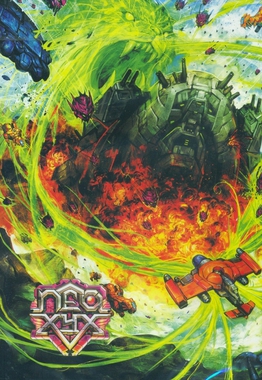
Quake III Arena is a 1999 multiplayer-focused first-person shooter developed by id Software. The third installment of the Quake series, Arena differs from previous games by excluding a story-based single-player mode and focusing primarily on multiplayer gameplay. The single-player mode is played against computer-controlled bots. It features music composed by Sonic Mayhem and Front Line Assembly founder Bill Leeb.

Radiant Silvergun is a shoot 'em up developed by Treasure. It was originally released in Japanese arcades in 1998 and subsequently ported to the Sega Saturn later that year. The story follows a team of fighter pilots in the far future who are battling waves of enemies summoned by a mysterious crystal dug up from the Earth. The player hosts an arsenal of six different types of shots to choose from, and a sword to destroy nearby targets. The stages are tightly designed to present players with scenarios that can be approached differently with the various weapon types.

Bangai-O is a multidirectional shooter developed by Treasure and released in 1999 on the Nintendo 64 in Japan. It was ported to the Dreamcast worldwide shortly after with some gameplay changes and updated graphics and audio. The game places the player in control of a weaponized mech that can hover across large stages and fire at enemies all around them. The player must reach the end of each stage and defeat the boss, while avoiding hazards scattered across the map such as enemy mechs and gun turrets.

Sonic Adventure is a 1998 platform game developed by Sonic Team and published by Sega for the Dreamcast. It was the first main Sonic the Hedgehog game to feature 3D gameplay. It follows Sonic the Hedgehog, Miles "Tails" Prower, Knuckles the Echidna, Amy Rose, Big the Cat, and E-102 Gamma in their quests to collect the Chaos Emeralds and stop Doctor Robotnik from unleashing Chaos, an ancient evil. Controlling one of the six characters—each with their own abilities—players complete levels to progress the story. Sonic Adventure retains many elements from prior Sonic games, such as power-ups and the ring-based health system. Players can play minigames such as racing and interact with Chao, a virtual pet.
Shoot 'em ups are a sub-genre of action games. There is no consensus as to which design elements compose a shoot 'em up; some restrict the definition to games featuring spacecraft and certain types of character movement, while others allow a broader definition including characters on foot and a variety of perspectives.

Ikaruga is a shoot 'em up developed by Treasure. It is the spiritual sequel to Radiant Silvergun (1998) and was originally released in Japanese arcades in December 2001. The story follows a rebel pilot named Shinra as he battles an enemy nation using a specially designed fighter called the Ikaruga which can flip between two polarities, black and white. This polarity mechanism is the game's key feature and the foundation for its stage and enemy design. All enemies and bullets in the game are either black or white. Bullets which are the same color as the player are absorbed while the others will kill the player. The game features both single-player and cooperative modes.

Border Down is a horizontally scrolling shooter video game developed and published by G.rev. It was released in Japanese arcades in April 2003 on Sega NAOMI hardware, and was ported to the Dreamcast later that year. The story takes place in the future where humans are defending their Mars colony from an invading alien attack. The game employs a "border system" where each stage has three variations of different difficulty. The player starts on the easiest variation, and is lowered to a more difficult variation with each subsequent loss of a life.

Twinkle Star Sprites is a 1996 competitive scrolling shooter arcade game originally created by ADK. It was ADK's last production for the Neo Geo platform. The gameplay, which can be characterized as a combination of a fixed shooter and a versus puzzle game, uses combinations of shots, as well as timed power-ups to attempt to damage the opponent. These attacks also serve as counters to the opponent's attack.

Gunbird 2 is a 2D scrolling shooter developed by Psikyo and published by Capcom as a sequel to the original Gunbird. It was originally released in Japanese arcades in 1998, and was later ported to the Dreamcast in 2000 and released worldwide. An Android version was released in Korea in 2014, before it came out worldwide on both Android and iOS in 2016. The arcade game was also included in Gunbird Special Edition for the PlayStation 2. A version was released on Nintendo Switch in June 2018, Microsoft Windows in June 2020, and PlayStation 4 and Xbox One in August 2022.
A beat 'em up is a video game genre featuring hand-to-hand combat against a large number of opponents. Traditional beat 'em ups take place in scrolling, two-dimensional (2D) levels, while a number of modern games feature more open three-dimensional (3D) environments with yet larger numbers of enemies. The gameplay tends to follow arcade genre conventions, such as being simple to learn but difficult to master, and the combat system tends to be more highly developed than other side-scrolling action games. Two-player cooperative gameplay and multiple player characters are also hallmarks of the genre. Most of these games take place in urban settings and feature crime-fighting and revenge-based plots, though some games may employ historical, science fiction or fantasy themes.

Radirgy is a shoot 'em up video game developed by MileStone Inc. and released for the Sega NAOMI arcade platform in 2005. The story follows schoolgirl Shizuru Kamigusa in an age filled with radio waves which she is allergic to. She must save her father, who is developing a remedy for her sickness, from terrorists who have taken control of his company. The game features bullet hell gameplay elements and a distinct cel shaded graphical style.

Under Defeat is a shoot 'em up video game developed by G.rev and released in Japanese arcades in 2005. The game takes place in an alternate reality during World War II, where players control German-speaking characters fighting against English-speaking characters. Their vehicles are patterned after those of real-life Allied and Axis powers. A port for the Dreamcast was released in 2006 and marketed as the last game for the system, although two more were released the following year. The game was commercially successful, but received average reviews from critics because of its traditional and derivative gameplay.

Last Hope is a single-player horizontally scrolling shooter for the Neo Geo AES, Neo Geo CD, and Dreamcast systems. It was developed by German developer NG:Dev.Team in 2006. While the Neo Geo version was self-published, the Dreamcast version was released by RedSpotGames in January 2007 as an unlicensed title. In 2009 the Dreamcast version received a reprint in the form of a director's cut called Last Hope: Pink Bullets which addressed several gameplay-related issues. A Neo Geo version of Pink Bullets was released in February 2011.

Fast Striker is a video game developed and published by German developer NG:Dev.Team in 2010 for the Neo Geo MVS. The player flies a space fighter craft through vertically scrolling levels to shoot waves of enemies. The game was later ported to Dreamcast, iOS, Neo Geo AES, PlayStation 4 and PlayStation Vita.

Gunlord is a 2012 single-player run and gun video game developed and published by German indie NG:Dev.Team for the Neo Geo MVS. It is the first run and gun title from NG:Dev.Team and their third game overall. Taking place after the events of Last Hope, the player assume the role of Gordian Gaiden facing against an evil lord called "The Master" on planet Kairos II while searching for his wife Vanessa, who went missing after defeating the evil empire. Inspired by 16-bit titles such as Turrican, the game originally started development in 2003 but was postponed for various years until the project was resumed in 2010, lasting eighteen months in production.

Chaos Field is a 2004 vertically scrolling shooter arcade video game developed by MileStone. The game consists entirely of boss battles, featuring five stages with three bosses each. The player can choose to play as one of three characters, each with their own ship that has a unique primary weapon. The player can flip the environment at will between two parallel worlds.

Xeno Crisis is a 2019 multidirectional shooter homebrew video game developed and published by Bitmap Bureau for the Sega Mega Drive/Genesis, Linux, macOS, Microsoft Windows, Nintendo Switch, PlayStation 4, and Xbox One. It was later ported to Dreamcast, PlayStation Vita, Neo Geo, Neo Geo CD, Nintendo 64, GameCube, and Super Nintendo Entertainment System. The premise takes place in Outpost 88, a scientific research facility overrun by aliens. The facility sent a distress signal, leading Commander Darius dispatching space marines John Marsh and Sarah Ridley to confront the aliens. Gameplay revolves around players defeating enemies, rescuing survivors, collecting in-game currency for upgrades, and facing against bosses.

Neo XYX is a 2013 single-player vertically scrolling shooter video game originally developed and published by German indie NG:Dev.Team for the Neo Geo MVS. It is the third shoot 'em up title from NG:Dev.Team and their fifth game overall. Controlling a space fighter craft, the player must fight endless waves of enemies while avoiding collision with their projectiles and other obstacles.
NGDEV, formerly NG:Dev.Team, is a German video game developer and publisher. Founded in 2001 by brothers Timm and René Hellwig, it is known for developing 2D homebrew games with arcade gameplay for the Neo Geo and Dreamcast.

Ghost Blade is a 2015 vertically scrolling shooter video game developed and originally published by German studio HUCAST Games as an independent commercial release for the Dreamcast. It was re-released between 2017 and 2018 by JoshProd. A high-definition version titled Ghost Blade HD was also released for PlayStation 4, Wii U, Xbox One, PC, and Nintendo Switch. Controlling one of three fighter crafts, the player fights to protect Mars against the corrupt artificial intelligence Shira. Its gameplay consist of five stages, with players gathering collectible items and defeating enemies to build combos and maintain a high-score, while avoiding collision with their projectiles and obstacles.

















